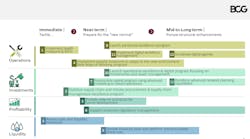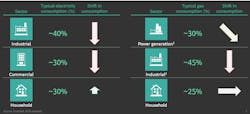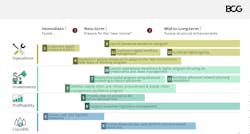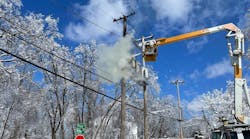COVID-19 has fueled what many think will be one of the worst economic periods in generations. The pandemic has hit the power and gas utilities sector with a number of simultaneous impacts never experienced before.
Network companies have not been immune to the crisis. During lockdown, the refrain has been to adapt in key areas — from employee health, business continuity, and customer service to workforce deployment, supply chain issues, and financial resilience. Energy network companies are experts in managing crises and are normally shielded from cash-flow impacts. Nevertheless, they too will have to make certain adaptations going forward. As restrictions begin to relax, operations and investment planning will be front and center. The actions taken now will prove crucial to weathering the turmoil in the near term and building resilience in the longer term.
COVID-19 Dynamics and Implications for Utilities
While normally shielded from stock market volatility, utilities have watched their market cap plummet over the past two months. European utilities saw share prices fall by 20% to 40% and U.S. utilities saw share prices fall by 10% to 30%. Countries most affected by the pandemic watched demand for electricity and gas fall to new lows, with industrial and commercial demand falling fast and hard (see Exhibit 1). Since Europe's shelter-in-place mandate began, household demand for electricity and gas rose by 5% to 10%, while industrial demand fell by 20% to 30% and commercial demand sank by 30% to 40%.
Addressing Worst-Case Scenarios During the Lockdown
The depth of the pandemic has important implications for an energy networks sector that typically excels in crisis management. As the restrictions gradually abate in large parts of the world, networks need to take precautionary measures in five key areas: team health and business continuity, customer service, workforce deployment, supply chain, and financial resilience.
Team health and business continuity
Network companies need to make employee health and safety a top priority while preserving business continuity. This can be a complex task, given the variety of roles and locations — field crews both outdoors and in substations, critical workers in control centers, and employees in offices. This means encouraging employees to work from home whenever possible and adopting safety measures for the rest, such as field crews and control room workers. To maintain business continuity, companies need to accelerate their digital readiness, heighten cybersecurity, and ensure regulatory compliance. Those with advanced field management capabilities will have an advantage.
Customer service and reliability of supply
In places where the spread of COVID-19 is rapid, demand for help from customers experiencing power outages has risen while distancing and lockdown measures have made it more difficult for contact centers to provide these services. For many network operators, the best solution is to create virtual contact centers.
Companies must also review how they prepare for power outages as well as how they provide planned access to the grid. Customers spending most of their time at home are more sensitive to planned and unplanned outages. It is essential to reach out to customers with critical needs in order to better understand their needs. This helps ensure that the power supply to critical locations, such as hospitals, is uninterrupted and that outages in residential areas are minimal. Also, network companies that delay disconnections for residential and small enterprise customers will earn some much-needed goodwill.
Workforce deployment
In some countries, lockdowns have severely affected workforce availability and ways of working. Network operators must continue critical maintenance activities while temporarily halting non-critical work such as meter reading and inspections. A network operator who wants to reduce physical interactions among crew members has several options. For example, companies are increasing the number of shifts, staggering hours, starting from home, and deploying small, fixed crews. These and similar workforce decisions are best made using digital productivity tools such as field-force management solutions.
Supply chain
The global pandemic also puts stress on global supply chains. For example, the availability of key network equipment such as transformers could potentially be affected, thereby increasing lead times and creating financial stress for vendors. Companies will want to monitor the potential for the contagion to further stress their supply chains. At the same time, there will be opportunities for procurement savings as competing demand dries up and commodity prices fall. Networks must regularly review their procurement strategies at both the category and supplier level to identify risks and capitalize on the right opportunities. Networks may decide to support small, local, at-risk suppliers that provide critical materials or components.
Financial resilience
Because of their regulatory constructs, network businesses normally do not experience cash flow challenges the way other sectors do. However, given the depth of this crisis, we expect them to feel the impact of the financial distress of retailers or, eventually, of policies established for networks to share financial burdens. In some locations, local currency fluctuations that increase sourcing costs could exacerbate the problems.
To address these issues in the near term, network companies will perform stress tests that indicate what could happen in different economic scenarios. They will then revise their financial plans accordingly and manage cash flow conservatively, while optimizing working capital and reviewing their approach to supplier financing. A network company that prioritizes its investments and manages its assets well will be in a better position liquidity-wise.
Building Resilience and Adapting to the "New Normal"
Once lockdown is lifted, it will be time to capture the lessons from the mitigation phase and decide which practices should continue and which ones should end. The idea is to pursue strategic responses that make critical areas more resilient over the long term while acknowledging that recovery could very well be gradual.
Operations
Regaining lost productivity requires employing new operating models and digital tools in key areas, such as control rooms, field services, and contact centers. For example, workforce efficiency can be enhanced by further up-skilling and cross-skilling, while also deploying field force management systems and focusing on frontline leadership enablement and data-driven performance management. Network companies are realizing that by leveraging digital solutions they can be more agile and provide smarter, more customer-facing activities.
Investment and maintenance
Network companies may want to incorporate a future grid vision into their investment planning, which has been impacted by a variety of conflicting factors. On the one hand, falling demand and a deteriorating financial position may make companies more cautious about grid investments. On the other hand, shareholders' expectations may prompt companies to make investments to offset their devalued assets. Governments may react to infrastructure investments with stimulus measures to boost economic recovery. Grid companies will want to support the right projects to avoid creating stranded assets.
Some uncertainty exists around the need for grid reinforcement to integrate renewable generation. Long-term power purchase agreements and negligible marginal costs make renewables more resilient than conventional generation. At the same time, falling oil prices and tighter financingNetwork companies are getting ready to respond to immediate issues, tackle the near-term challenges and opportunities, and prepare for longer-term structural enhancements. Those that learn from the pandemic — and are able to deploy digital technologies in planning and operations — will be well-placed in the near term and far more resilient over the long term.




